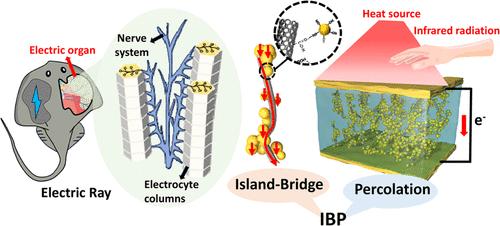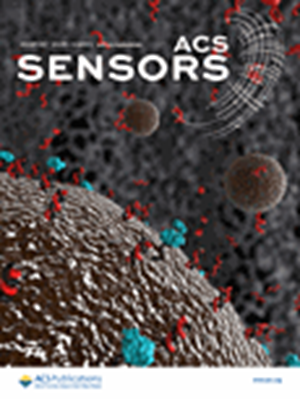IF 8.2
1区 化学
Q1 CHEMISTRY, ANALYTICAL
引用次数: 0
摘要
大面积柔性热释电传感器在电子皮肤、机器人和军事等一系列应用中受到越来越多的关注。然而,现有的柔性热释电传感器很难同时实现高热释电性能和优异的机械性能。在此,我们提出了一种通用的岛桥渗滤结构,其灵感来自电射线的电器官,可使具有优异机械性能的柔性非热释电基底产生热释电效应。由热释电粒子(岛)和羧基功能化多壁碳纳米管(桥)组成的岛桥渗滤网络结构通过薄膜极化和渗滤效应实现了热释电效应的传输和叠加。基于岛桥渗滤网络结构的热释电传感器不仅继承了热释电粒子的热释电特性,还继承了非热释电基底的优异机械特性。利用聚二甲基硅氧烷(PDMS)基底制作的柔性热释电传感器即使在 30% 的拉伸率和 5,000 次拉伸-回缩循环条件下也能表现出良好的热释电效应和出色的机械可靠性;利用聚酰亚胺(PI)基底制作的柔性热释电传感器可作为机器人的电子皮肤来检测热源,并具有最大距离为 8 厘米的红外感应特性。这项研究为制造具有高柔性和高性能的柔性热释电传感器提供了思路。本文章由计算机程序翻译,如有差异,请以英文原文为准。

Electric-Ray-Inspired Universal Island-Bridge Structure for Transforming Nonpyroelectric Substrates into Pyroelectric Sensors
Large-area, flexible pyroelectric sensors have received increasing attention in a range of applications including electronic skin, robotics, and military. However, existing flexible pyroelectric sensors struggle to achieve both high pyroelectric performance and excellent mechanical properties simultaneously. Here, we propose a universal island-bridge percolation structure inspired by the electric organ of the electric ray that can enable flexible nonpyroelectric substrates with excellent mechanical properties to generate a pyroelectric effect. The island-bridge percolation network structure made of pyroelectric particles (island) and carboxyl-functionalized multiwalled carbon nanotubes (bridge) achieved the transmission and superposition of the pyroelectric effect through the film polarization and percolation effect. The pyroelectric sensor based on the island-bridge percolation network structure not only inherits the pyroelectric properties of the pyroelectric particles but also inherits the excellent mechanical properties of the nonpyroelectric substrates. The flexible pyroelectric sensors fabricated from polydimethylsiloxane (PDMS) substrates exhibit a good pyroelectric effect and excellent mechanical reliability even under 30% tensile rate and 5,000 tensile–retraction cycles, and those made from polyimide (PI) substrates can serve as electronic skin for robots to detect heat sources and possess infrared sensing properties with a maximum distance of 8 cm. This study provides ideas to fabricate flexible pyroelectric sensors with highly flexible and high-performance properties.
求助全文
通过发布文献求助,成功后即可免费获取论文全文。
去求助
来源期刊

ACS Sensors
Chemical Engineering-Bioengineering
CiteScore
14.50
自引率
3.40%
发文量
372
期刊介绍:
ACS Sensors is a peer-reviewed research journal that focuses on the dissemination of new and original knowledge in the field of sensor science, particularly those that selectively sense chemical or biological species or processes. The journal covers a broad range of topics, including but not limited to biosensors, chemical sensors, gas sensors, intracellular sensors, single molecule sensors, cell chips, and microfluidic devices. It aims to publish articles that address conceptual advances in sensing technology applicable to various types of analytes or application papers that report on the use of existing sensing concepts in new ways or for new analytes.
 求助内容:
求助内容: 应助结果提醒方式:
应助结果提醒方式:


